Figures & data
Table 1 Polyphenolic content of New Zealand blackcurrant juice
Table 2 Participant physical and fitness evaluations
Table 3 Profile of mood states (POMS) of participants
Fig. 1 Timed New Zealand blackcurrant juice (BJ) consumption inhibits platelet monoamine oxidase-B (MAO-B) activity. Platelet MAO-B activity was measured in participants who had consumed either a placebo (PLA) or BJ drink 1 h prior to performing a low impact walking exercise. Platelets from blood collected at baseline (filled bars), pre- (unfilled bars) and post- (hatched bars) exercise were measured for MAO-B activity using commercial Amplex® Red Monoamine-B assay kit. Results are expressed as mean ± SEM, n = 20 individuals per group. * p < 0.05 and **p < 0.01 represents statistical difference from baseline and pre-exercise values respectively within the PLA or BJ groups
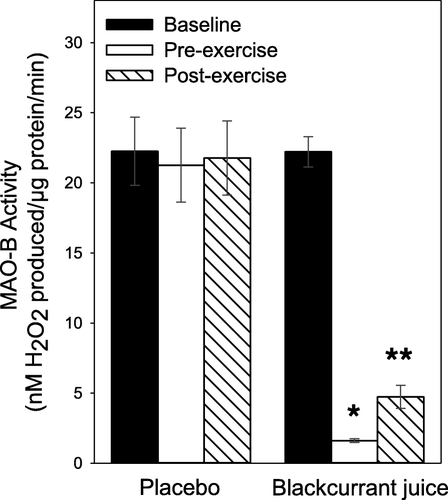
Fig. 2 Timed consumption of New Zealand blackcurrant juice (BJ) modulates blood lactate but not glucose levels . Blood glucose [a] and lactate [b] levels was measured in participants who had consumed either a placebo [PLA] or BJ drink 1 h prior to performing a low impact walking exercise. Blood glucose or lactate collected at baseline (filled bars), pre- (unfilled bars) and post- (hatched bars) exercise was measured using either HemoCue® Glucose 201 or Arkray Lactate Pro™ 2 biosensors, respectively. Results are expressed as mean ± SEM, n = 20 individuals per group. * p < 0.05 and **p < 0.01 represents statistical difference from baseline and pre-exercise values respectively within each group
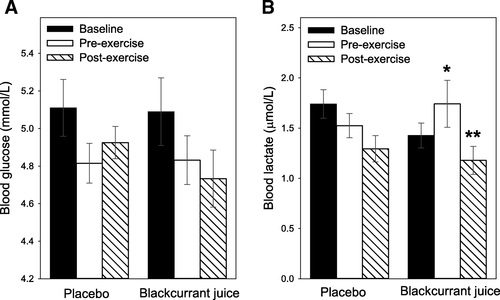
Fig. 3 Timed consumption of New Zealand blackcurrant juice (BJ) has no impact on exercise-induced changes in heart rate (HR) or oxidative stress biomarker malondialdehyde (MDA). Participants consumed either a placebo (PLA) (open circles) or BJ (filled circles) drink 1 h prior to being performing a low impact treadmill waking exercise. a HR was measured using a PolarTM heart monitor and expressed as mean ± SEM beats per minute (bpm). b Plasma MDA was measured pre- (unfilled bars) and post- (hatched bars) exercise by high pressure liquid chromatography (HPLC). Results are expressed as mean ± SEM, n = 20 individuals per group
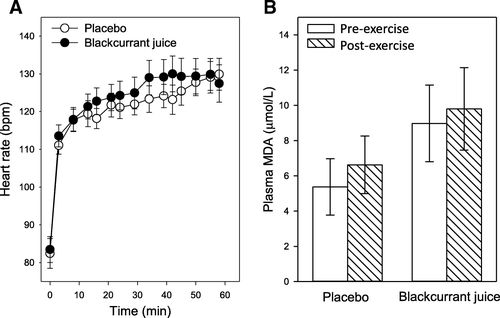
Fig. 4 Timed consumption of New Zealand blackcurrant juice (BJ) has a marginal influence on the drop-out time and distance walked by participants. a Exercise drop-out time and [b] distance walked was recorded during a low impact treadmill walking exercise. Results are expressed as either [a] a step-wise plot of participant’s drop-out time in placebo (PLA, open circles) or BJ (filled circles) groups or [b] Box and Whisker plot of distance walked by participants in the two groups; n = 20 per group; centre line of box indicates median, box encloses the middle 50% of values; whiskers mark the 10 and 90% percentiles of the data, and dots mark observations beyond those
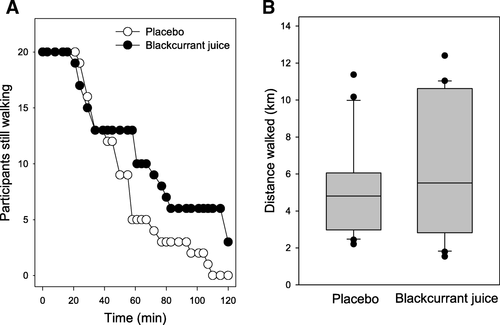
Fig. 5 Timed consumption of blackcurrant juice (BJ) modulates affective responses during a moderate walking exercise. Affective responses for perceived exertion [a] and feeling/mood [b] by participants who had either consumed placebo (PLA, open circles) or BJ drink (filled circles) 1 h prior to performing a low impact exercise were assessed visual analogue scale [VAS] sheets at 3 or 5 mins intervals. Results are expressed as mean ± SEM, n = 20 individuals per group. *p < 0.05 represents statistical difference from PLA at corresponding walking time
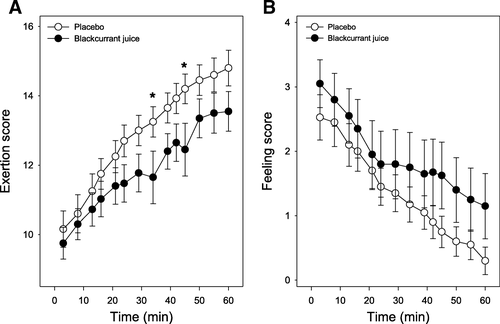
Fig. 6 Timed consumption of New Zealand blackcurrant juice (BJ) skews the inverse relationship between perceived exertion (ES) and feeling/mood (ES) scores during exercise. Correlation between ES and FS (assessed using visual analogue scales [VAS]) reported by participants who had consumed either [a] placebo (PLA) or [b] BJ drinks 1 h prior to performing a low impact walking exercise is expressed as circumplex plots. Results are calculated as ‘last number carried forward’ and expressed as mean ± SEM for each intervention group
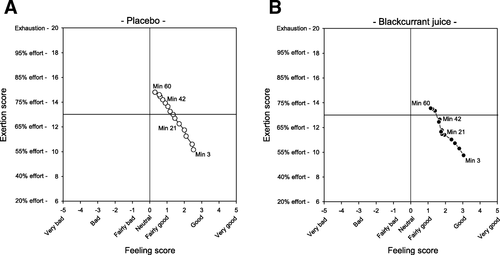
Availability of data and materials
The data sets for this manuscript are not publicly available because of commercial sensitivity. Requests to access the datasets should be directed to the corresponding author.
